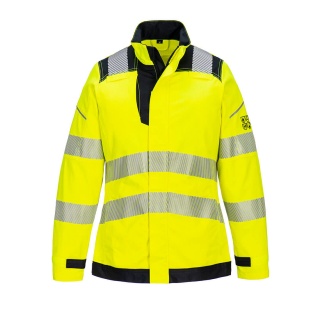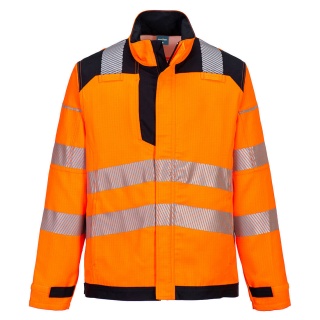Developed for the demanding environment of aluminium, iron and steel works
The inherent lightweight fabric offers maximum protection.
Fabric Information:
Bizflame Ultra is blended from 80% cotton, 19% FR polyester and 1% carbon fibre, 340g. The FR polyester content in Bizflame Ultra provides excellent abrasion, shrinkage and colour fastness. The fabric is tough enough to withstand the rigours of industrial laundry making it ideal for the off shore industry
Fabrics:
 Bizflame Ultra: 80% Cotton, 19% Polyester, 1% Carbon Fibre 340g
Bizflame Ultra: 80% Cotton, 19% Polyester, 1% Carbon Fibre 340g
Features:
- CE-CAT III
- Protection against radiant, convective and contact heat
- Certified protection against molten metal splash
- 100% metal free
- Industrial laundry wash 75°C and tunnel dry 155°c
- Sew on flame resistant industrial wash tape
- Anti-static
- Curved back hem for added protection
- Radio loops for easy clipping of a radio
- Hook and loop cuffs for a secure fit
- Washable at 60 Degrees
Product Technical Information
Standards
-
ELIM TESTING IN PROGRESS
-
EN ISO 11612 A1+A2, B1, C1, E2, F1
-
EN ISO 11611 Class 1 A1 + A2
-
EN 1149 -5
-
IEC 61482-2 IEC 61482-1-2 Class 1
-
EN 13034 Type PB [6]
-
ASTM F1959/F1959M-12 ATPV 16 CAL/CM2 (HAF 83.7%)
Washcare
Documentation
EN ISO 11612:2008
Protective Clothing Against Heat and Flame
The Performance requirements set out in this international standard are applicable to garment, which could be worn for a wide range of end uses, where the is a need for clothing with limited flame spread properties and where the used can be exposed to radiant, convective or contact heat or molton metal splashes.
This test uses standard methods and conditions to predict the performance of fabric/garment in the event of contact with heat or flames. Garment features such as seams, closures and logos must be tested as well as the fabric. Tests must be carried out on pre=treated components according to the manufacturers care label.
Specific Testing is listed below:
- Dimensional Charge
- Limited Flame Spread (A1+A2)*
- Convective Heat (B) – 3 Levels
- Radiant Heat (C) - 4 Levels
- Molten Aluminium Splash (D) – 3 Levels
- Molten Iron Splash E - 3 Levels
- Contact Heat (F) – 3 Levels (Temp 250 Degrees Celcius)
- Heat Resistance at a temperature of 180 Degrees Celcius
- Tensile Strength Must meet a minimum of 300N
- Tear Strength must meet a minimum of 15N
- Bursting Strength
- Seam Strength
Garment Design requires that coverage must be provided from the neck to the wrist and to the ankles.
Optional Testing includes water vapour resistance and manikin testing for overall burn prediction.
*This test must be carried out on fabric and seams.
EN1149 -5
Protective Clothing against the Thermal Hazards of an Electric Arc
This European Standard is part of a series of standards for test methods and requirements for electrostatic properties of protective clothing. The standard specifies material and design requirements for garments used as part of a total earthed system, to avoid incendiary discharges. The requirements may not be sufficient in oxygen enriched flammable atmospheres. This standard is not applicable for protection against mains voltages.
EN 1149 consists of the following parts:
EN 1149-1: Test Method for measurement of surface resistivty.
EN 1149-2: Test Method for measurement of the electrical resistance through a material (Vertical resistance)
EN 1149-3: Test Methods for measurement of charge decay.
EN 1149-4: Garment Test (under development)
EN 1149-5: Material Performance and design requirements.
Electrostatics dissipative protective clothing shall be able to permanently cover all non-complying materials during normal use. Conductives parts (Zips, Buttons etc) are permitted provided they are cover by the outermost material when in use.
IEC 61482-2: 2009
Protective Clothing Against The Thermal Hazards of An Electric Arc
This standard specifies requirements and test methods applicable to materials and garments for protective clothing against the thermal effects of an electric arc event. An electric arc is a continuous electric discharge of high current between conductors generating very bright light and intensive heat.
Two international test methods have been developed to provide information on the resistance of clothing to the thermal effects of electric arcs. Each method gives different information. To comply with our standard either or both tests must be carried out.
Box Method EN 61482-1-2
The fabric/garment is exposed to an electric arc confined in a specific box with a specific electrode arrangement for 0.5 seconds. Class 1 is to the current of 4kA arc, Class 2 is to a current 7 kA arc. Test conditions for Class 1 and 2 try to stimulate typical exposure conditions for a short circuit current of 4kA and 7kA respectively.
Open Arc Method EN61482-1-1
This test method aims to establish the ATPV (Arc Thermal Performance Value) of Ebt (Energy Breakopen Threshold) of a fabric. The APTV is the amount of energy required to cause a 2nd degree burn through the material prior to breakopen (50% probability). The EBT is the amount of energy where the material breaks-open (50% probability). This is normally the upper thermal limit of the fabric where the fibres are damaged and material loses mechanical strength, Both APTV and Ebt are expressed in calories per cm2.
| Chest | XS | S | M | L | XL | XXL | XXXL |
| Inches | 32 - 33 - 34 | 36 - 38 | 40 - 41 | 42 - 44 | 46 - 47 - 48 | 50 - 52 | 54 - 55 |
| CM | 80 - 84 - 88 | 92 - 96 | 100 - 104 | 108 - 112 | 116 - 120 - 124 | 128 - 132 | 136 - 140 |
| Euro | 40 - 42 - 44 | 46 - 48 | 50 - 52 | 54 - 56 | 58 - 60 - 62 | 64 - 66 | 68 - 70 |
Click here for more information and full size guide










